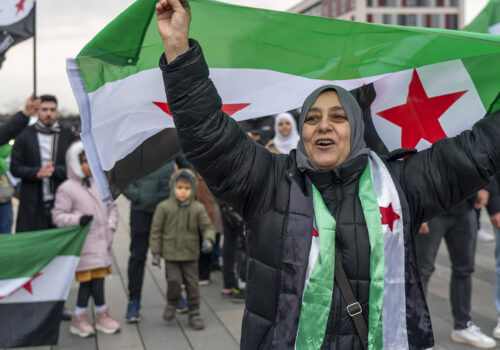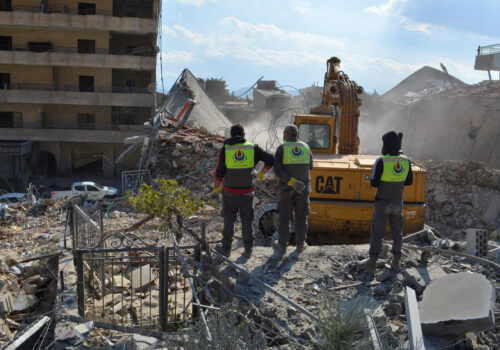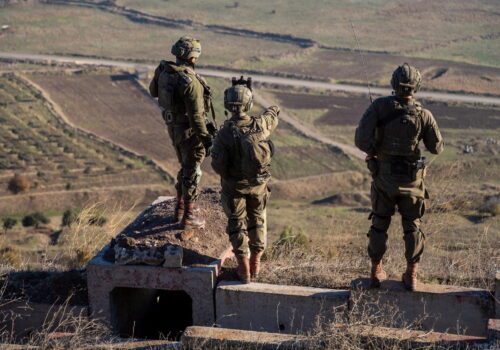From rubble to rebirth: A model for Syria’s reconstruction
Almost six months have passed since Bashar al-Assad’s regime fell in Syria. The most notable event of this transitional phase was the establishment of a new Syrian government in late March 2025, consisting of twenty-three ministers from different backgrounds.
The new government has inherited the aftermath of more than five decades of authoritarian rule, compounded by the devastating consequences of nearly fourteen years of armed conflict. In addition, Syria continues to grapple with the impact of harsh international sanctions, which were imposed in response to the al-Assad regime’s widespread human rights violations. These challenges have rendered Syria a fragile state, with its institutions on the verge of total collapse.
However, the fall of the dictatorial regime and the formation of a new government offer an opportunity to begin rebuilding state institutions. Whether this new Damascus can seize this opportunity relies on four key pillars: achieving security and political stability, fostering inclusive political participation, establishing justice as a precondition for sustainable peace, and lifting sanctions to prevent the resurgence of violence.
The first pillar: Security and political stability
A deeply fragile security landscape, shaped by two major challenges, hinders Syria’s progress toward stability.
The first challenge is that the regions outside of the new Syrian government’s control, particularly the Jazira region of Eastern Syria—the provinces of Hasakah, Raqqa, and the eastern part of Deir ez-Zor—are currently under the authority of the Syrian Democratic Forces (SDF). In March 2025, Syrian President Ahmed al-Sharaa and SDF commander Mazloum Abdi signed an agreement outlining the integration of the SDF into the institutions of the newly formed Syrian state. However, the agreement remains vague in its provisions and lacks a concrete timeline for implementation.
Subsequently, it is imperative that the international coalition—led by the United States, which still maintains military presence in Syria—plays a proactive role in facilitating the agreement’s execution. This involves applying political pressure and actively sponsoring dialogue between the parties to foster mutual understanding and avoid any potential military confrontation.
Nevertheless, spoilers are working to derail any potential agreement between the Syrian government and the SDF. Among them is the hardline faction within the SDF, primarily composed of foreign cadres affiliated with the Kurdistan Workers’ Party (PKK). They oppose the agreement because its implementation would significantly diminish their influence, including restoring Damascus’s authority over oil and gas sites currently under SDF control. The shift would also undermine the influence of prominent SDF warlords, many of whom are PKK affiliates wielding unchecked authority.
Consequently, they have sought to escalate tensions and resist cooperating with the new administration, as seen with the SDF’s recent crackdown on civilians who displayed the new Syrian national flag. Moreover, according to human rights organizations, the SDF arrested 93 civilians in March 2025, including seven children.
The second challenge is Israel’s incessant military operations, which pose grave risks for Syria, the region, and Israel itself.
Fragmentation of the Syrian state could invite renewed foreign interference, particularly from Iran, which may view Syria’s weakened and divided state as a strategic opportunity to expand its influence.
But for Israel, the military campaign in Syria serves an objective of systematic destruction of Syrian military infrastructure to prevent the rebuilding of a functional defense apparatus. This also assists Israel in implementing a new regional security landscape, aimed at obstructing stabilization efforts through continued airstrikes and ground incursions.
Change in this calculus must come through pressure. The international community—particularly the European Union, Arab states, and the United States—must exert more meaningful and sustained diplomatic efforts to halt Israel’s military actions if they want to achieve sustainable peace in Syria.
The second pillar: Inclusive political participation
In Syria, decades of exclusion and sectarian domination under the al-Assad regime dismantled social cohesion and eroded political trust. It will be crucial to establish a political system that ensures genuine participation for all societal components—political, sectarian, ethnic groups, and civil society organizations. Such a system must provide for the equitable distribution of political and administrative influence through effective participatory mechanisms.
While the new Syrian administration has launched a national dialogue and appointed a qualified government, political participation must go beyond surface-level representation. Participatory governance must be the foundation for rebuilding state institutions. Any political exclusion or power monopolization risks driving certain groups toward disengagement or opposition, transforming them from constructive participants into potential nemeses of the political process.
Achieving this requires pursuing two complementary paths: both a top-down and a bottom-up approach.
The top-down model necessitates that the government lead by initiating structured and transparent programs that facilitate political inclusion. This includes continuing the national dialogue on foundational issues like transitional justice, constitutional reform, state structure, the political system, and foreign relations. These dialogues must be inclusive and truly representative of Syria’s diverse fabric.
Notably, Syrian public opinion demonstrates clear rejection of sectarian-based systems, favoring instead frameworks rooted in civil representation and citizenship. The new Syrian government must treat all Syrians as individual citizens, rather than as members of religious or ethnic groups, and anchoring national discourse in the concept of citizenship is fundamental.
Equally vital is the bottom-up role of civil society in advancing political transition and decision-making. Civil society should be granted the necessary space to operate freely, reflecting Syrian societal dynamics and avoiding inflaming social sensitivities. Valuable lessons can be drawn from the experiences of exiled Syrian civil actors, who—during the war—demonstrated a clear willingness to engage politically. According to the literature, these initiatives reveal strong potential for grassroots engagement. Building on these experiences is crucial for forming a cohesive, credible civil society capable of playing a constructive role in stabilization and institutional rebuilding.
The third pillar: Transitional justice
Transitional justice is pivotal for achieving sustainable peace in Syria. After more than a decade of violent conflict—fueled by an authoritarian regime responsible for killing hundreds of thousands and displacing millions—there is growing consensus that any political settlement that neglects Syrians’ demands for accountability will neither end the violence, nor enable legitimate and stable state building.
Lack of transitional justice fosters a culture of impunity and fuels the risk of renewed violence, driven by cycles of personal and collective vengeance. As numerous studies have shown, accountability goes beyond a legal or ethical imperative—it is a structural requirement for achieving long-term stability and peace.
It also includes a social and moral process that must begin with public acknowledgment of the suffering endured by victims and their families throughout the 14-year war. Such acknowledgment lays the groundwork for reparations and paves the way for meaningful national reconciliation, helping to move beyond nearly half a century of repression and violence.
SIGN UP FOR THIS WEEK IN THE MIDEAST NEWSLETTER
The literature on conflict and transitional justice highlights the importance of context-specific approaches. In Syria, this means that transitional justice must be rooted in the aspirations of Syrians, particularly survivors of violence, internally displaced persons, and refugees. Empirical research on Syrian refugee communities abroad confirms that many see justice as essential to achieving sustainable peace.
Therefore, the new government needs to initiate a transparent and credible transitional justice process supported by the international community. This process must include well-defined implementation mechanisms aligned with international legal standards and grounded in justice and human rights principles. Moreover, it should avoid transplanting external justice models, as approaches that are not adapted to Syria’s social and political context may reinforce ethnic and sectarian divisions rather than heal them.
This effort demands sincere political will, robust institutional frameworks, and the active participation of a broad range of actors, including human rights and legal organizations, civil society groups, and local communities. Furthermore, sustained support from international institutions, particularly the United Nations, is essential to ensuring the effectiveness of the transitional justice process.
The fourth pillar: Lifting sanctions
In the wake of the regime’s collapse, lifting sanctions has become paramount to achieving two core objectives. First, enabling the reconstruction of state institutions. And second, alleviating the profound economic suffering endured by the Syrian civilian population.
The continuation of sanctions severely impedes stabilization and early recovery efforts. Without access to financial and material resources, the state remains incapable of delivering basic services, perpetuating Syria’s status as a fragile state. This vacuum risks fostering environments conducive to radicalization and renewed violence, which could destabilize Syria and the broader region.
Years of economic isolation have induced severe shortages in basic goods, rampant inflation, record unemployment, and a dramatic depreciation of the Syrian pound. These conditions have exacerbated poverty and social disintegration, undermining any prospect for national reconciliation and peacebuilding.
Economic sanctions against Syria are exceedingly complex. Following the outbreak of the Syrian revolution in 2011, the United States, the European Union, and the United Nations imposed comprehensive sanctions in response to the al-Assad regime’s widespread violence against civilians.
US sanctions have proven to be the most stringent, as they are open-ended with no built-in expiration, unlike EU sanctions, which are subject to annual renewal. Additionally, US sanctions on Syria predate the 2011 uprising, tracing back to 1979 when Washington designated Syria a State Sponsor of Terrorism. The most expansive US sanctions to date were imposed after 2011, culminating in the Caesar Act, which significantly intensified financial and economic restrictions on the regime and its affiliates.
While reports have surfaced indicating that the United States has outlined certain conditions for sanction relief—such as addressing the issue of foreign fighters—it is imperative that the new Syrian administration prioritize meaningful internal reforms. These reforms should include guaranteeing fundamental rights, refraining from suppressing individual freedoms, enhancing transparency, and reinforcing the rule of law. Commitment to these principles will likely prove more effective in building international confidence than focusing solely on foreign policy overtures.
Rebuilding Syrian state institutions in the post-Assad era requires a comprehensive, multi-dimensional approach integrating security and political stability, inclusive political participation, transitional justice, and sustained efforts to lift economic sanctions. Achieving this requires the support of both international actors and local stakeholders to ensure sustainable peace and stability.
Mahmood Alhosain is a PhD candidate in Conflict and Peace Studies in the political science department at Radboud University. His areas of interest focus on: Post-conflict studies, development, and deconstruction.
Further reading
Mon, Mar 31, 2025
Western sanctions against Damascus must evolve—just as Syria has
MENASource By Sinan Hatahet
The US can play a pivotal role in shaping the next chapter of Syria's recovery by shifting its approach from maximum pressure to calibrated influence.
Tue, Mar 25, 2025
Dispatch from Bekaa: Inside the sectarian skirmishes on the Syria-Lebanon border
MENASource By Nicholas Blanford
Local Shia tribesmen have battled an assortment of Sunni jihadist militias and the new Syrian security forces dominated by Hayat Tahrir al-Sham (HTS).
Tue, Apr 1, 2025
Israel is making a miscalculation in southern Syria. Here is why.
MENASource By Ömer Özkizilcik
Israel’s approach in southern Syria risks deepening sectarian divisions, eroding the Druze community’s standin, and fueling broader instability.
Image: A torn poster showing former Syrian President Bashar al-Assad meeting with Iran's Supreme Leader Ayatollah Ali Khamenei, in the Sayyida Zaynab district in Damascus, Syria, December 14, 2024. REUTERS/Amr Alfiky



